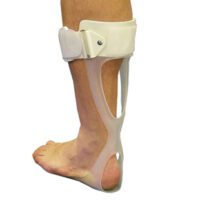Tibialis Posterior Tendinopathy
Article by Zoe Russell

Tibialis Posterior Tendinopathy
What is Tibialis Posterior Tendinopathy?
Tibialis Posterior Tendinopathy, a condition that disrupts the tibialis posterior tendon’s normal function, often triggers foot arch pain and discomfort. Situated along the lower leg’s interior, behind the ankle bone, and extending to the midfoot, this tendon plays a pivotal role in supporting the foot’s arch and ankle stability. It is also known as Posterior Tibial Tendon Dysfunction (PTTD). It is a common cause of foot arch pain and can predispose you to plantar fasciitis, flat feet and heel spurs.
The Mechanics of Tendinopathy
Tendinopathy refers to the pain or dysfunction of a tendon, a problem that can emerge suddenly or develop over time due to repetitive loads. Aging frequently leads to structural changes in the tendon’s collagen, which can result in increased foot arch falling in or pronation, particularly noted in older women. Nonetheless, factors like a change in activity levels, inadequate footwear, or prior ankle injuries can also contribute to this condition across different age groups.
Spotting Posterior Tibial Tendon Dysfunction
Posterior Tibial Tendon Dysfunction (PTTD) can arise from various causes, such as overtraining, abrupt changes in training surfaces, or even excessive uphill running. It manifests when the load on the tibialis posterior tendon—whether compressive, tensile, or a combination—exceeds what it can adapt to.
Common Causes of Tibialis Posterior Tendinopathy
Load-related factors, like sudden increases in training intensity or transitioning to harder training surfaces, often precipitate tendinopathy. Biomechanical issues such as flat feet, inadequate hip and knee control, or tight calf muscles also contribute significantly to the problem.
Diagnosing Tibialis Posterior Tendinopathy

A physiotherapist can diagnose Tibialis Posterior Tendinopathy through clinical assessment, relying on the history of symptoms and a physical examination. Unlike other conditions, PTTD typically does not necessitate imaging for diagnosis.
Tibialis Posterior Tendinopathy Treatment Approaches
Effective management of Tibialis Posterior Tendinopathy is multifaceted. It involves decompression, load management, progressive loading of the tendon, and addressing biomechanical factors that contribute to the condition.
Decompression and Load Management
The initial step in treating PTTD involves reducing the abusive load on the tendon by identifying and modifying activities that exacerbate the condition. Lower-impact training and additional foot support can be integral to managing the pain in the short term.
Progressive Loading
A cornerstone of PTTD management, progressive loading strengthens the tendon gradually. Exercises may start with isometric actions and advance through concentric, eccentric, and plyometric stages, increasing the load progressively.
Biomechanical Considerations
Addressing biomechanical contributors is essential. This may encompass exercises for foot stability, hip and glute strengthening, core stability, and proprioception. For some, podiatric input may be necessary to facilitate recovery with extra footwear support.
Expected Outcomes
PTTD generally has a favourable prognosis with early identification and treatment. However, cases with delayed diagnosis may require more comprehensive management involving both physiotherapy and podiatry. The rehabilitation program will be tailored to each individual’s response to treatment, guided by clinical testing and personal goals.
Exploring Novel Therapies
While novel treatments like injection therapies and shockwave therapies offer mixed results, they remain an area of active research. A physiotherapist can discuss whether such treatments are appropriate on a case-by-case basis.
Conclusion
Tibialis Posterior Tendinopathy, a significant cause of foot arch pain and dysfunction, requires a structured approach for effective management. By understanding the causes, implementing a personalised treatment plan that includes decompression, load management, and progressive loading, and addressing any biomechanical factors, individuals can expect a return to their daily activities and sports with reduced risk of recurrence. As with any medical condition, early diagnosis and treatment are crucial, and ongoing research continues to refine these approaches for even better outcomes.
For specific treatment advice, please book an appointment with your PhysioWorks physiotherapist.
Rochedale - Call 38410277
Book Online: RochedaleSalisbury - Call 32751044
Book Online: SalisburySandgate - Call 32691122
Book Online: SandgateRelated Articles
- Pes Planus – Flat Feet: This article explains the condition of flat feet, characterised by the collapse or flattening of the medial longitudinal arch. It details how this condition leads to the midfoot region pronating towards the ground, sometimes even touching it, resulting in hyperpronation or overpronation.
- Anterior Ankle Impingement: Discusses various conditions leading to ankle discomfort, including flat feet. It emphasises the importance of addressing systemic conditions like rheumatoid arthritis that may manifest as ankle pain.
- Ankle Strapping: Provides comprehensive information on managing pain and inflammation for a sprained ankle, highlighting the role of flat feet in contributing to ankle pain.
- Peroneal Tendinopathy: Focuses on the condition affecting tendons on the outside of the ankle, mentioning symptoms and contributing factors such as flat feet.
- Ankle Pain: Describes how flat feet can lead to ankle pain and stresses the importance of addressing biomechanical issues.
- Bunion Management and Treatment Options: Provides information on foot conditions like bunions and their management, mentioning flat feet as a related condition.
- Tarsal Tunnel Syndrome: Mentions flat feet in the context of foot health and their potential connection to Tarsal Tunnel Syndrome.










































































